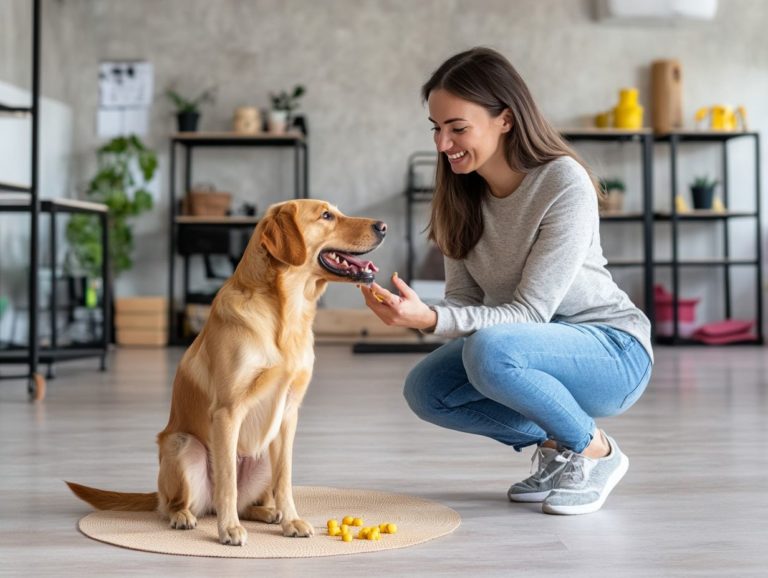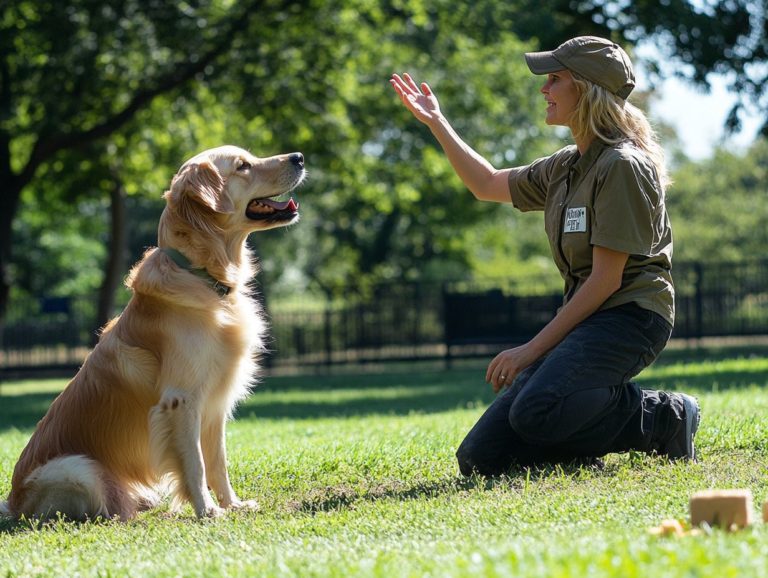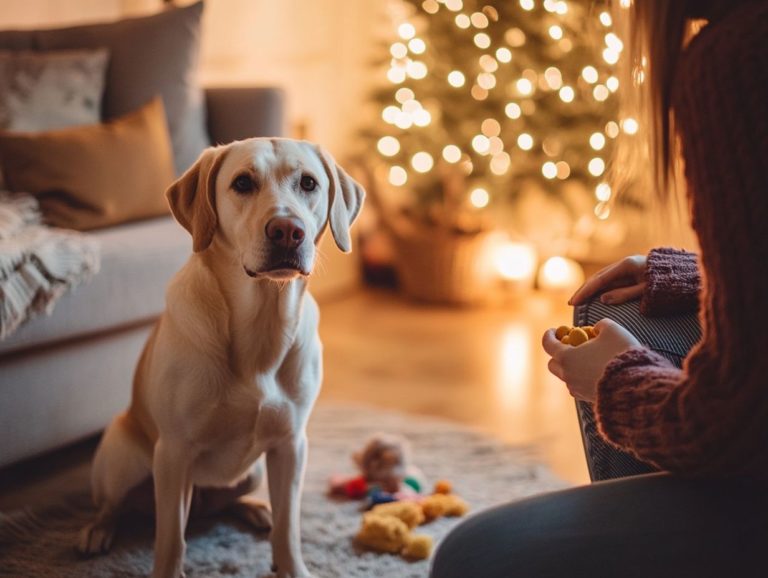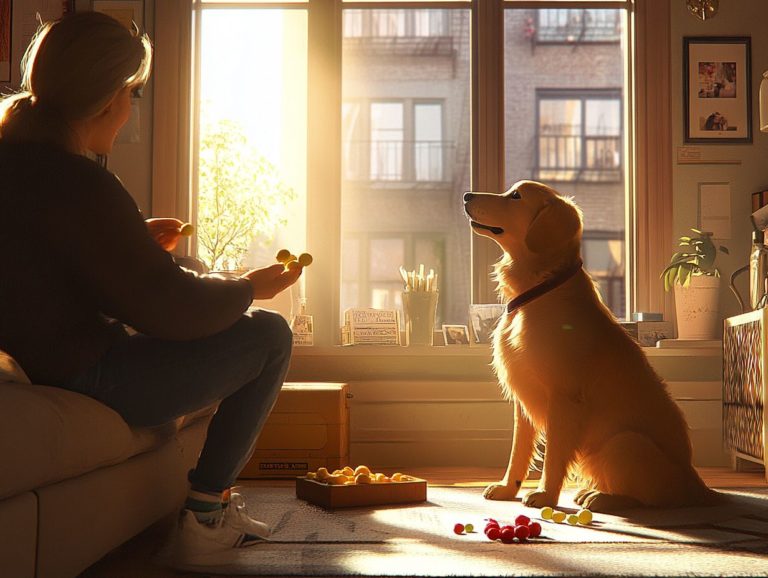Training Techniques to Manage Aggression in Anxious Pets
Understanding aggression in anxious pets is essential for dog owners. It directly influences your dog’s behavior and emotional well-being.
Many pet owners face behavioral challenges rooted in anxiety, which often reveals itself as aggression. Watch for fear aggression in your dog a response that occurs when a dog reacts aggressively out of fear.
This article delves into the underlying causes of such behavior, providing practical training techniques, including positive reinforcement and changing behavior.
You ll find valuable strategies like environmental enrichment and professional guidance. By taking proactive measures, including proper socialization classes and understanding the way dogs communicate through their body movements and expressions, you can significantly reduce aggression and improve your pet’s overall well-being.
Explore the insights ahead to pave the way for a more peaceful relationship with your furry companion!
Contents
- Key Takeaways:
- Understanding Aggression in Anxious Pets
- Common Training Techniques for Aggression Management
- Additional Strategies for Managing Aggression
- Working with a Professional Trainer
- Preventing Aggression in Anxious Pets
- Frequently Asked Questions
- What are some common training techniques to manage aggression in anxious pets?
- What is desensitization and how can it help manage aggression in anxious pets?
- Can counterconditioning be effective in managing aggression in anxious pets?
- What is positive reinforcement training and how can it be used to manage aggression in anxious pets?
- How important is consistency in training when managing aggression in anxious pets?
- Are there resources for learning how to manage aggression in anxious pets?
Key Takeaways:
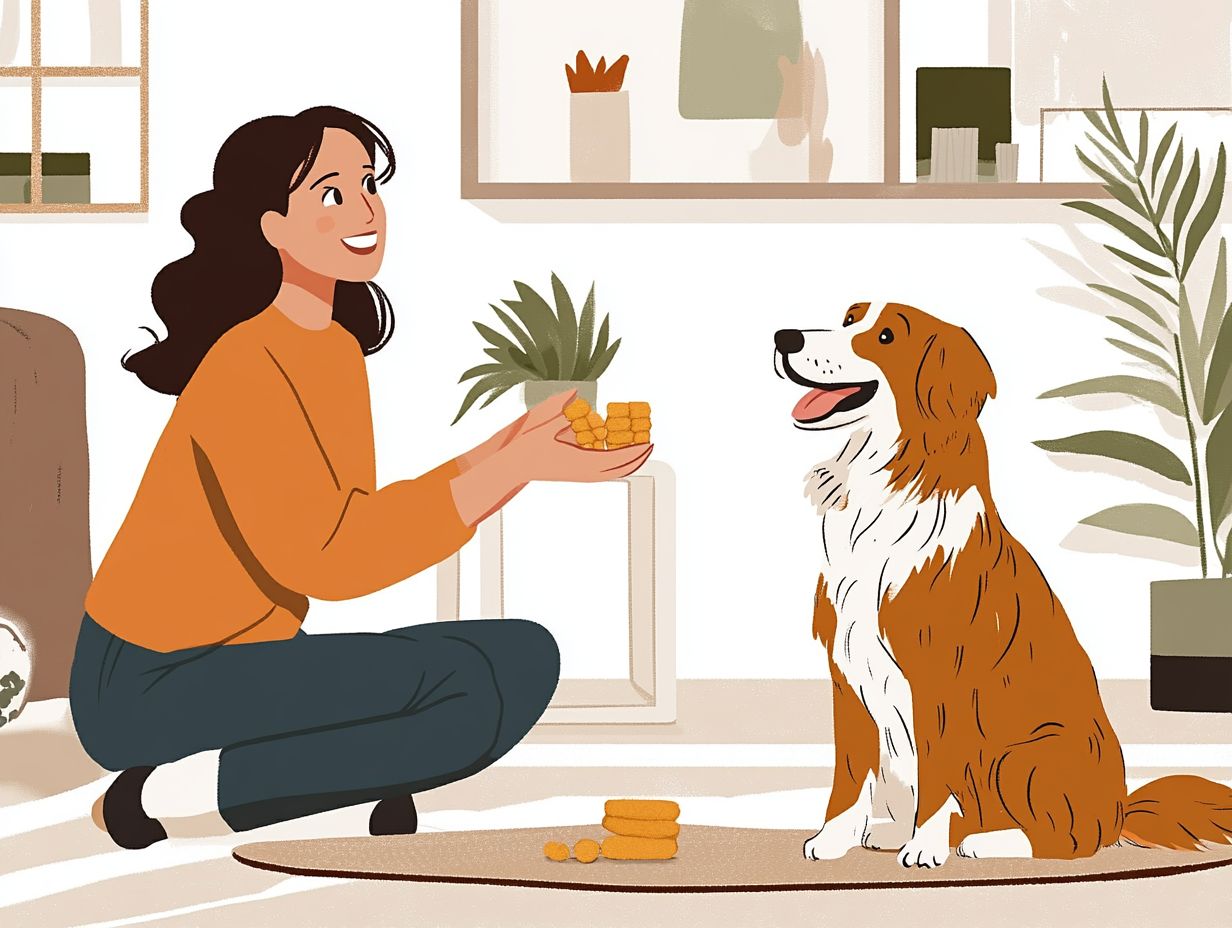
- Aggression in anxious pets can be caused by specific triggers and underlying issues, such as fear aggression or past trauma.
- Positive reinforcement, behavior modification, and getting your pet used to things slowly are effective training techniques for managing aggression in anxious pets.
- Environmental enrichment, medication, supplements, and working with a professional trainer can help manage aggression in anxious pets.
Understanding Aggression in Anxious Pets
You may notice fear aggression due to your dog s struggle to manage specific triggers. This behavior can create misunderstandings and strain your relationship.
Proper socialization classes are essential for addressing these behaviors. By recognizing the signs of fear, you ll find a complete approach that combines effective training with emotional support.
This fosters a more harmonious bond with your furry companion.
Causes and Triggers
The causes and triggers of aggression in dogs arise from a complex interplay of environmental and psychological factors. These are often rooted in fear aggression and the dog’s past experiences.
Consider this: a dog might react aggressively to loud noises or unfamiliar settings, all of which can elevate their anxiety levels. An anxious dog s behavior is often heavily influenced by previous traumas, such as abuse or neglect.
Socialization is essential; if a dog misses exposure to various people, animals, and situations during critical developmental phases, it can lead to increased fear and aggression. Understanding these triggers is vital for effective behavior modification.
Common Training Techniques for Aggression Management
Training techniques for managing aggression in dogs emphasize positive reinforcement and changing behavior. A key aspect of this is understanding basic commands for anxious pets, which are essential for transforming aggressive behaviors into more desirable actions.
Positive Reinforcement
Positive reinforcement is an exceptionally effective training technique that centers on rewarding desirable behaviors in dogs. This fosters improved confidence and a more harmonious relationship with you as their owner.
This approach is based on the understanding that dogs are more inclined to repeat behaviors that receive positive reinforcement, like calmly sitting or eagerly responding to your commands.
For instance, offering treats, praise, or quality playtime can transform the training process into a joyful learning experience. If you have an anxious dog, employing this technique can significantly reduce their fears and help build trust.
A skilled dog trainer can customize rewards to align with your dog’s individual temperament and preferences, ensuring they feel valued and secure in their environment. This not only enhances training outcomes but also nurtures a deeper bond between you and your furry companion.
Behavior Modification
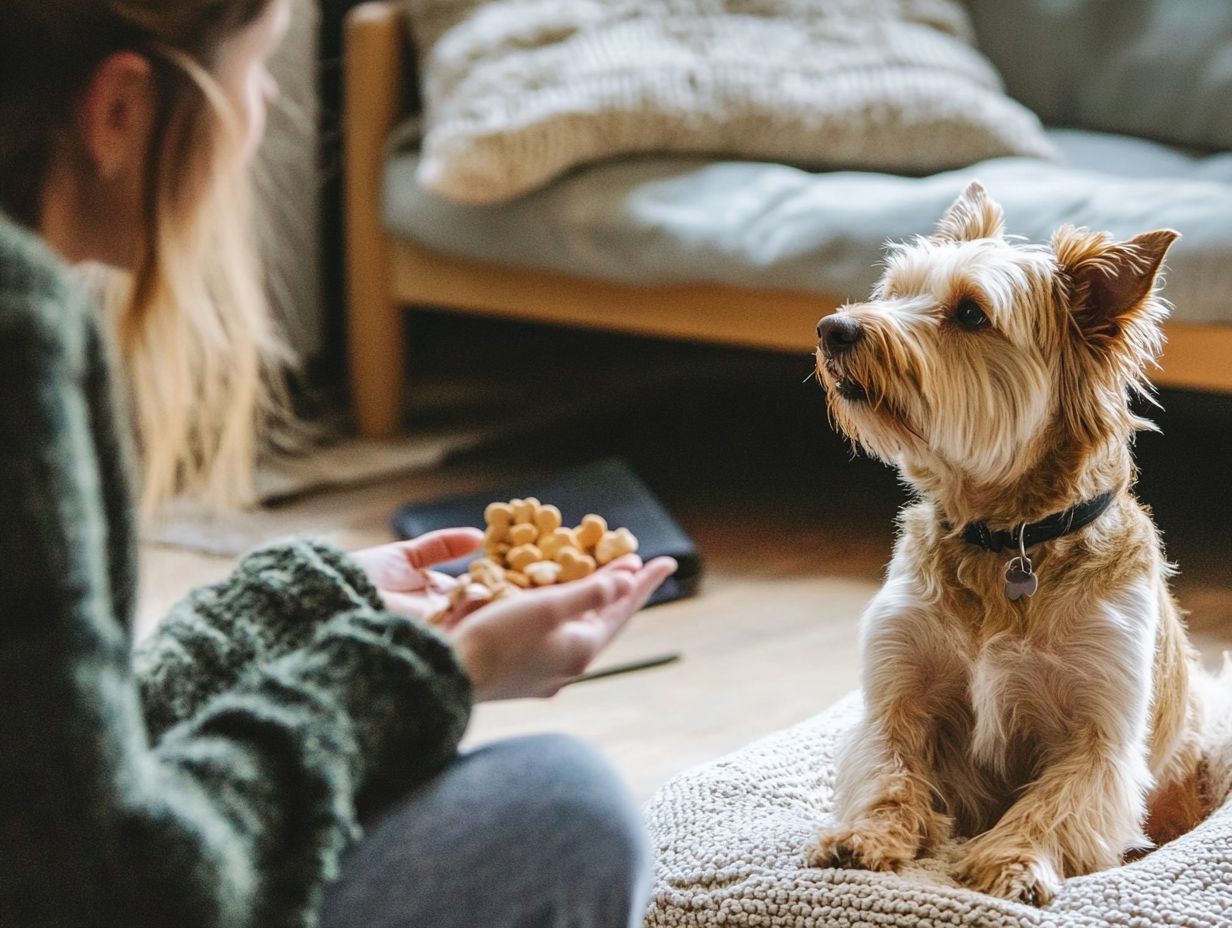
Behavior modification techniques are vital for addressing the root causes of aggression in dogs. Identifying the specific triggers that incite such responses is crucial.
These triggers may arise from factors like fear, territorial instincts, or past trauma. Tailoring techniques like desensitization and counter-conditioning can lead to significant progress in managing these behaviors.
For example, if your dog growls at strangers, gradually exposing them to unfamiliar people in controlled environments combined with positive reinforcement can be highly beneficial.
In this context, enlisting the help of a veterinary behaviorist is essential. They can craft comprehensive behavior modification plans tailored to your dog’s needs. They might also recommend specific training tools or therapies, such as pheromone diffusers or anxiety-reducing supplements, to assist your dog on the path to a more balanced demeanor.
Desensitization and Counterconditioning
Desensitization and counterconditioning are powerful techniques for helping your dog manage fear aggression. Gradually exposing them to their triggers can effectively change their emotional response, and understanding anxious behaviors in pets can further enhance your approach.
These methods do more than just alleviate fear; they foster positive associations with stimuli that once seemed intimidating. For instance, when your dog encounters a loud noise that sends them into a panic, desensitization works to lessen that fear over time.
Counterconditioning can involve pairing that noise with delightful treats or exciting playtime, transforming their emotional reaction.
Understanding your dog s body language is vital in this journey. Paying attention to subtle cues, such as tail position or ear movement, helps gauge how your dog is adjusting.
This insight allows you to customize your approach, ensuring that each session builds a foundation of security and trust.
Additional Strategies for Managing Aggression
Along with effective training techniques, consider integrating additional strategies to manage aggression in dogs. For example, using music to calm anxious pets during training and enhancing their environment through enrichment can make a significant difference.
Thoughtfully using medication and supplements can also support behavioral changes, creating a more harmonious atmosphere for both you and your canine companion.
Environmental Enrichment
Environmental enrichment is about providing your dog with a delightful array of stimuli and activities. This approach helps alleviate anxiety and curb unwanted aggressive behaviors while reinforcing positive actions.
Countless ways exist to achieve this, such as:
- Regular physical activities like invigorating walks and spirited games of fetch
- Introducing stimulating toys that challenge their intellect
- Fostering social interactions with other dogs or people
Incorporate these practices into your dog s daily routine. This not only enhances their physical well-being but taps into fundamental principles of canine psychology highlighting the critical role of mental stimulation.
Using positive reinforcement techniques, like rewarding your dog for solving a puzzle or engaging playfully with others, harmonizes with these enrichment methods. This creates an environment where both learning and bonding flourish, enriching the lives of both you and your furry companion.
Medication and Supplements
Sometimes, medication and supplements, including behavioral medications, are essential for managing aggression, especially in severe cases or those with underlying trauma.
Behavioral medications, such as selective serotonin reuptake inhibitors (SSRIs) and atypical anxiolytics, target specific aspects of anxiety in dogs. Supplements like L-theanine and CBD oil have gained popularity for their calming properties.
As a pet owner, it s vital to consult a veterinary behaviorist. They can develop a tailored treatment plan that addresses your dog s unique needs, ensuring an effective and safe course of action that goes beyond just prescriptions.
Don’t wait to start these techniques your dog s happiness and safety depend on it!
Working with a Professional Trainer

Collaborating with a professional dog trainer or veterinary behaviorist is essential for effectively addressing aggression in anxious pets. These experts offer customized strategies that leverage positive reinforcement for anxious pets and proven techniques, ensuring your furry companion receives the best guidance for their unique needs.
Benefits and Considerations
The advantages of partnering with a professional dog trainer are substantial and tailored to your needs. You gain access to personalized training plans that deepen your understanding of canine behavior.
Effective communication strategies designed specifically for you as a pet owner are also included. This collaboration often results in remarkable training outcomes, especially when the trainer uses positive reinforcement techniques.
Choosing the right trainer is crucial for your success. Ensure their credentials and experience align with your dog’s specific requirements, whether that involves obedience training, behavioral correction, or socialization.
Compatibility between the trainer and your dog is key. A trainer who understands your dog’s unique temperament and personality can tailor strategies to achieve the best results.
Preventing Aggression in Anxious Pets
Preventing aggression in anxious pets calls for active steps, emphasizing the importance of effective socialization techniques. For more insight, check out best practices for pet anxiety training. Teaching dogs to recognize and respond appropriately to various triggers creates a harmonious environment for your pet and those around them.
Proactive Measures for Long-Term Success
Implementing proactive measures for long-term success involves continuous training, proper socialization, and a deep understanding of how dogs think and behave.
By enrolling your dog in training classes, you can reinforce positive behaviors while enhancing communication. Grasping canine body language is essential; recognizing signs of anxiety or discomfort like tail tucking or growling enables you to intervene before situations escalate.
Socialization opportunities, such as visiting dog parks, should always be supervised to ensure a positive experience. Creating a calm, reassuring environment helps your dog feel safe and fosters better social skills, reducing the likelihood of aggressive behavior.
Frequently Asked Questions
What are some common training techniques to manage aggression in anxious pets?
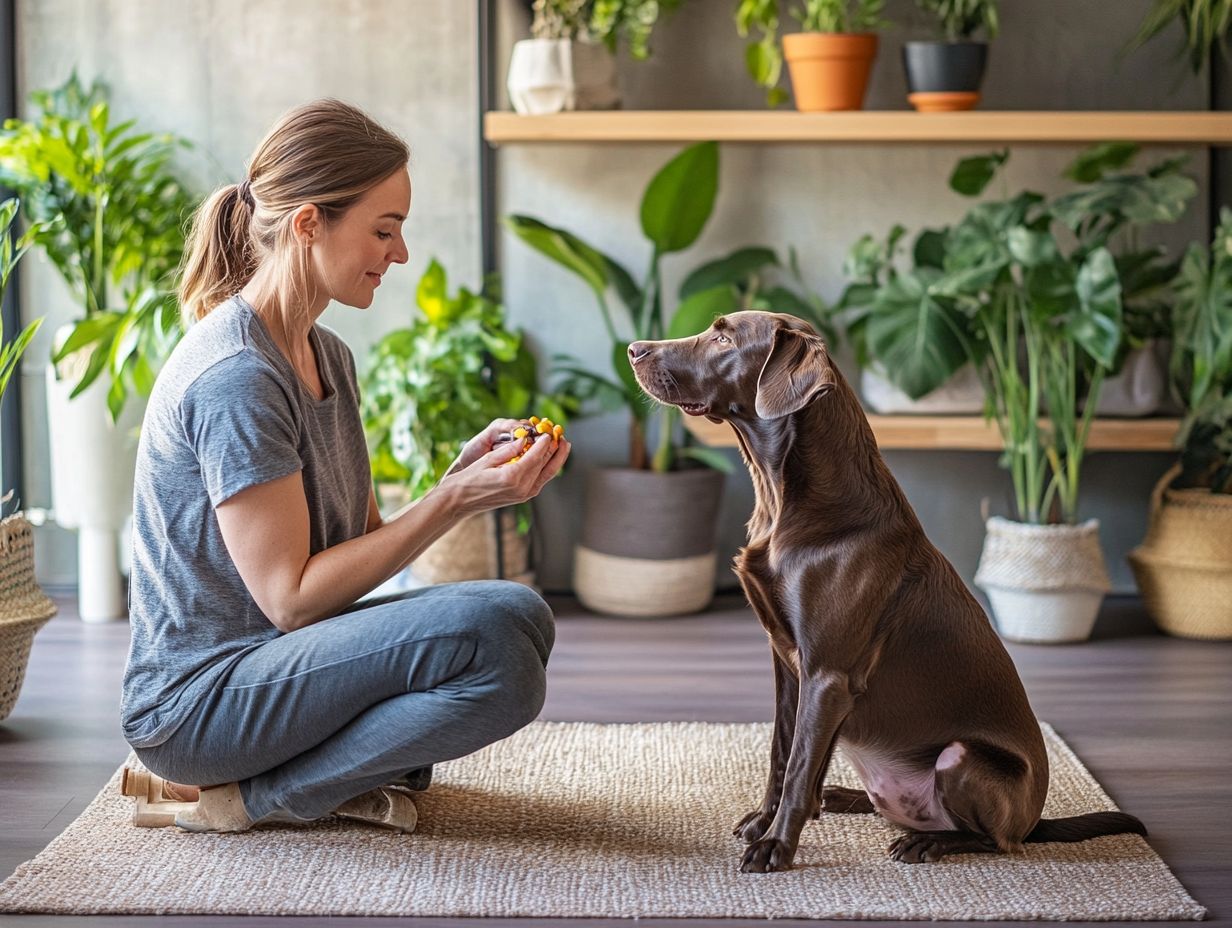
- Desensitization
- Counterconditioning
- Positive reinforcement training
What is desensitization and how can it help manage aggression in anxious pets?
Desensitization involves gradually exposing your pet to the situation or trigger that causes aggression. Start with low intensity and gradually increase it over time to help your pet react less.
Can counterconditioning be effective in managing aggression in anxious pets?
Yes, counterconditioning pairs the trigger that causes aggression with something positive, such as treats or toys, to create a positive association and reduce anxiety and aggressive behavior.
What is positive reinforcement training and how can it be used to manage aggression in anxious pets?
Positive reinforcement training rewards desired behaviors with treats, toys, or praise. This approach not only reinforces calm and non-aggressive behavior in anxious pets but also helps in utilizing obedience training to ease anxiety by teaching them alternatives.
How important is consistency in training when managing aggression in anxious pets?
Consistency is crucial, as any changes in training can undo progress and reinforce negative behaviors. All household members should use the same training techniques.
Start implementing these training techniques today to ensure a well-adjusted pet. If you need professional help, don t hesitate to reach out!
Are there resources for learning how to manage aggression in anxious pets?
Yes! There are many resources available, including books, online articles, and trainers who specialize in anxious and aggressive pets.
Do your research and talk to an expert before starting any training. This will help ensure you choose the best methods for your pet’s needs.


